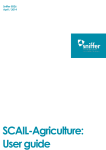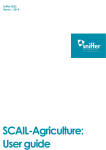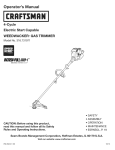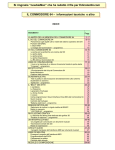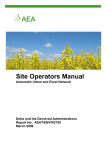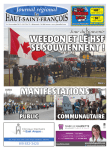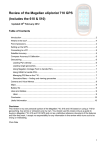Download SCAIL User Guide
Transcript
SCAIL-Combustion User Guide SCAIL-Combustion is a simple screening tool for assessing impacts from pollutant sources on habitats and ecosystems. The SCAIL-Combustion user guide provides information on IPPC, critical loads and the model, as well as providing a walk-through of the system itself. You will be shown how to complete a query using the web form and how to interpret the results. Contents 1 INTRODUCTIONS ....................................................................................................................... 1 LEGISLATIVE INTRODUCTION ................................................................................................. 1 SO2 INTRODUCTION .............................................................................................................. 2 NOX INTRODUCTION ............................................................................................................. 2 CRITICAL LOADS AND LEVELS ............................................................................................... 2 METEOROLOGY ..................................................................................................................... 3 1.1 1.2 1.3 1.4 1.5 2 THE SCAIL-COMBUSTION WEB SYSTEM ..................................................................................... 3 2.1 2.2 2.3 2.4 2.5 2.6 2.7 2.8 2.9 2.10 2.11 3 SCAIL-COMBUSTION DECISION FLOW CHART ...................................................................... 3 FILLING OUT THE FORM ......................................................................................................... 4 ENTERING INPUT DATA ......................................................................................................... 5 PROJECT DETAILS & RUN MODE .......................................................................................... 5 LOCATION DETAILS ............................................................................................................... 5 ENTERING SOURCE DETAILS ................................................................................................. 6 SAVING THE INPUT FILE ......................................................................................................... 8 CLEARING THE FORM ............................................................................................................ 8 RUNNING THE MODEL ............................................................................................................ 8 INTERPRETING THE RESULTS................................................................................................ 8 OPTIONS AFTER RUNNING THE MODEL ............................................................................... 10 APPENDIX 1: TYPICAL METEOROLOGICAL YEAR WIND ROSES ................................................. 11 4 APPENDIX 2: FORMAT OF AERMOD SITE SPECIFIC SURFACE (.SFC) AND PROFILE (.PFL) METEOROLOGICAL FILES. ................................................................................................................. 42 1 Introductions 1.1 Legislative introduction Emissions of NOx and SO2 from combustion sources and their subsequent deposition to sensitive ecosystems impose an environmental burden both nationally and internationally. At - a local scale the deposition of nitrogen and sulphur in the forms of nitrate (NO3 ) and sulphate 2- (SO4 ) can result in acidification of soils in sensitive ecosystems. The precursor gases; NOx (= sum of NO and NO2) and SO2, are controlled under the UNECE and EC emissions abatement agreements of the Gothenburg Protocol by the National Emissions Ceilings Directive, the Directive on Integrated Pollution Prevention and Control (IPPC), the Pollution Prevention and Control (Scotland) Regulations 2000, the Pollution Prevention and Control Regulations (Northern Ireland) 2003 and the Environmental Permitting (England and Wales) Regulations 2007. Permits are required for combustion installations with a rated thermal input exceeding 20MW. 1 If there is the potential for deposition to have an impact on a site with a conservation designation (e.g. Special Area of Conservation (SAC) or a national Site of Special Scientific Interest (SSSI) ) then this potential impact needs to be considered. Further help and guidance can be found at: http://www.scottishairquality.co.uk | http://www.sepa.org.uk | http://www.apis.ac.uk | PPC regulations for NI | UK Air Quality Archive 1.2 SO2 Introduction Sulphur dioxide (SO2) is produced when a material, or fuel, containing sulphur is burned. Globally, much of the SO2 in the atmosphere comes from natural sources, but in the UK the predominant source is power station burning of fossil fuels, principally coal and heavy oils. Widespread domestic use of coal can also lead to high local concentrations of SO 2. Even moderate concentrations may result in a fall in lung function in asthmatics. Tightness in the chest and coughing occur at high levels, and lung function of asthmatics may be impaired to the extent that medical help is required. Sulphur dioxide pollution is considered more harmful when levels of particulate and other pollution concentrations are also high. 1.3 NOx Introduction Nitric oxide (NO) is mainly derived from road transport emissions and other combustion processes such as the electricity supply industry. NO is not considered to be harmful to health. However, once released to the atmosphere, NO is usually very rapidly oxidised to nitrogen dioxide (NO2), which is harmful to health. NO2 and NO are both oxides of nitrogen and together are referred to as nitrogen oxides (NO x). Nitrogen dioxide can irritate the lungs and lower resistance to respiratory infections such as influenza. Continued or frequent exposure to concentrations, that are typically much higher than those normally found in the ambient air, may cause increased incidence of acute respiratory illness in children and other vulnerable adults. 1.4 Critical Loads and Levels Critical Loads/levels are the threshold level for the deposition or concentration of a pollutant above which harmful indirect effects may occur on a habitat or species, according to current knowledge. Additional deposition above the Critical Load/Level is termed Critical Load/Level Exceedance. For combustion processes we are primarily interested in SO2 and NOx emissions which lead to sulphur and nitrogen being deposited onto vegetation which may be harmful. Deposition is always quoted in kg of sulphur or nitrogen per hectare per year (kg S/ha/yr and kg N/ha/yr respectively). If you imagine 15 kg of nitrogen being emptied onto a sensitive bog ecosystem every year, where the bog has a critical load of 5-10 kg N/ha/yr you can imagine the likely impacts. Remember that a critical load has been set to protect the vegetation but symptoms may not be visible for up to 20 years. Further information on critical loads can be found at: www.apis.ac.uk/overview/issues/overview_Cloadslevels.htm. 2 1.5 Meteorology The SCAIL-Combustion screening model uses an approach that uses data from a single nearby meteorological station. The Typical Meteorological Year approach is used to derive meteorological data to best represent the long-term dataset based on the similarity of the annual wind direction distribution to the long-term average (five year). Similarity of long-term wind direction distributions of nearby stations has been used to reduce the number of meteorological stations used. The 30 stations included in the model are shown in Figure 1. Figure 1: 30 Meteorological Station used in SCAIL- Combustion 2 The SCAIL-Combustion Web System This section will provide a brief walk-through of the system and guide you through the form filling exercise and interpretation of the results. 2.1 SCAIL-Combustion decision flow chart Figure 2 shows the flow diagram of the SCAIL combustion tool and the decisions that may be taken in carrying out an environmental assessment. Since the tool compares a number of critical limits for habitats, obtaining no exceedance on all limits may be difficult. Where critical loads are already exceeded by the background or the new installation results in an exceedance further detailed modelling and site surveys should be carried out. In these situations an appropriate assessment would be needed to determine if the installation can be permitted or not. Please contact the appropriate environment agency for more information and guidance - Scotland: [email protected]; England/Wales: [email protected] ; Northern Ireland: [email protected] 3 Input habitat details Add in all sources (new and existing) Check current Background Levels of habitat using ‘Check Background Levels’ Button Run Model Save output to your own computer for future reference Not exceeding critical limits (2 green lights) Check whether new sources will cause an exceedance in SO2, NOx, N Dep or Acid Dep for both worse case and realistic scenarios Exceeding critical limits in both realistic and worse case scenario (2 red lights) Exceeding critical limits in worse case scenario (1 green, 1 red light) No further action Report results as necessary More detailed modelling required More detailed modelling required Figure 2: SCAIL Combustion flow chart 2.2 Filling out the Form Throughout the SCAIL-Combustion web system the user is provided with guidance notes by using the information icon ( ). By rolling the mouse over the icon (see Figure 3) text is displayed in the grey box giving guidance on the relevant input field. Figure 3: How to use the guidance info tool 4 2.3 Entering Input Data All the information needed to run the model is entered on the web form. However, if you have saved input data from a previous run, this can be loaded by clicking on the Load Input Data button at the top-right of the form. This will bring up a window where the input file can be selected and loaded. This will populate the form with the saved input data, ready to run. 2.4 Project Details & Run Mode In the Project Notes box you can enter details on the sources to be modelled and the type of run being carried out, e.g. ‘worst case’ or ‘realistic’. This information is copied onto the output screen and also to any output files saved. For the Project Run Mode, either Conservative or Realistic Met can be chosen. Realistic Met will use the actual position of the habitat site, and Conservative Met will rotate the habitat site so that it is in the prevailing wind direction for the meteorological file being used and hence receive the highest amount of pollutant concentration and deposition. The ‘Conservative Met’ assumption can help to ensure that the effects of local wind fields are captured. However, the method works best for situations where there are either single stacks or stacks are closely grouped, and care needs to be taken with stacks that are widely spaced apart. As a general rule run the model for both ‘Conservative Met’ and ‘Realistic Met’ situations. Details of the meteorological sites included in SCAIL-Combustion can be seen in Appendix 1. 2.5 Location Details For each site query you will need to choose a UK country. Then select the habitat type of the habitat in question. It may be a SSSI or an SAC or hold some other form of protection. Selecting the correct habitat will ensure the correct critical load is applied. If in doubt as to what your habitat is, please use your best judgment. If the habitat is in Scotland then you can use the SNHi Habitat check button which will take you to the Scottish Natural Heritage website to verify the habitat type. Then add the grid reference of the location of the habitat. The grid reference can be entered either as a Landranger grid reference (e.g. SE453275)– or as OS x,y grid coordinates in metres. For a location in Northern Ireland only Irish Grid x,y grid coordinates can be entered. If you are having problems in finding out the grid reference of the habitat location you can make use of multimap.com. Zoom in on the location and the Landranger grid reference is given at the bottom of the map. To verify the location of your grid reference, click on the Verify Location button to display the location on multimap.com. This option is not available for NI sites. 5 Figure 4: Entering the location details At this stage you can use the Check Background Levels button to check the background concentration and deposition levels for each pollutant at the habitat grid reference entered and then compare these levels with the Critical Load/Level of the selected Habitat Type (Figure 5). This information will open in a new window. Figure 5: Background Levels for habitat at Grid Reference SE453275 Users of the model should be aware of the issue of double counting as model predictions from existing sources may be included in the estimates of background concentrations or depositions. Clicking Upload Local Met Data, the user can also upload site specific meteorological data (site specific surface (.sfc) and profile (.pfl) meteorological files). 'The use of the Met Upload tool is, however, recommended for expert users only. The correct format for inputting into AERMOD is required for a successful run. Please refer to Appendix 2 for the correct format. 2.6 Entering source details Enter the details for each source (Figure 6). If you want to use multiple sources, fill in the details for one source, including information about the stacks, then select Add Source from the Source drop-down and fill in the details for the additional source. Sources can be removed using the red delete button. Up to 20 sources can be added. If your model run is for a new or proposed installation or source, select 'New'. If you are including an existing source select 'Existing'. The Number of Stacks box will update automatically as stacks are added. 6 Figure 6: Adding sources Now enter the details for each stack (Figure 7). Each source may have multiple stacks and additional stacks may be added after completing the information for each stack using the Stack drop-down. The user can enter information for up to 10 stacks per source. Make sure that you use the correct units for each of the parameters asked for. SO 2 and NOx emission rates may be entered in g/s, kg/day or tonnes per year. If the emission rate is not known, it can be calculated from concentration and volume flux data using the Emission Calculator button. You should give a grid reference for each stack, which can be provided as OS Landranger or OS x,y coordinates as for the habitat location. For a location in Northern Ireland only x,y grid coordinates can be entered based on the Irish Grid. Figure 7: Entering first stack details Once all the stack information has been added, you can either add an additional stack for the same source or add a new source as described above (Figure 8). Figure 8: Entering details for an additional stack 7 If less than 20 stacks are being assessed then the user can enter each stack as an individual source. This has the advantage that each stack can be given a specific name/identifier and the results on the output page will be shown for each stack separately within the source information box, which may make the interpretation of the results easier. In all other cases outputs for each stack entered from an individual source will be grouped together and be shown as the total deposition and air concentrations for the source assessed. 2.7 Saving the input file Use the Save input data button (Figure 9) to save all the information entered on the form for this project. This will enable the same scenario to be run again or modified without having to enter all the information again. A file called AERMOD.INP will be saved. This file should be renamed if you want to save multiple runs in the same folder. If you forget to save the input data at this stage, it can be saved from the results page after the model has run. 2.8 Clearing the Form If you want to clear the form, deleting all the sources that have been set up, click on the Clear Form button. If the input data is required later, make sure you have saved the data first using the Save Input Data button. 2.9 Running the model Before running the assessment tool you can add any additional information about the Sources and Stacks being considered in the Notes box. This information will be copied onto the output screen and also to any output files saved. Once you are happy that all the information has been correctly entered on the form, click the Run Model button to run the assessment. Figure 9: Buttons to run the model, save the input data or clear the form 2.10 Interpreting the Results Once the assessment has run, you will be presented with the results page. 8 Figure 10 shows summary information on the location, habitat details and the nearest met station used in the model run. CUSTMET refers to the use of custom met data. Figure 10: site information summary showing nearest met station. Figure 11 shows a breakdown of the total deposition to the habitat is given together with the background deposition, based on the grid reference supplied for the habitat. The critical load based on the habitat type is also provided. A critical load exceedance (total deposition critical load/level) is then calculated and displayed for NO x, SOx, Nitrogen Deposition and Acid Deposition. A positive value indicates an exceedance. In addition to the exceedance a percentage of the total concentration and deposition is given in relation to the critical load/level. A value greater than 100% indicates an exceedance of that critical limit. SCAIL Combustion is a screening tool to give an estimate of the concentrations and depositions at a habitat based on the source pollutant emissions and background levels. SCAIL Combustion can be used to determine if a more detailed assessment needs to be done, or if it can be quickly concluded that a combustion installation does or will not affect a designated site. For situations where the total concentration or deposition is estimated to be near to or exceeding a habitat’s critical load/level, further detailed modelling and site specific investigations might be needed to determine if the combustion installation can be permitted or not, depending on the level of exceedance. Please contact the appropriate environment agency for more information and guidance - Scotland: [email protected]; England/Wales: [email protected] ; Northern Ireland: [email protected]. 9 Figure 11: Results screen 2.11 Options after running the model At the bottom of the results page are several options (Figure 12). The Save Results button will save the output data in CSV (comma separated variables) format, which can be opened in Microsoft Excel. The Save Inputs button can be used to save the input data for this model run if it was not saved on the input form before running the model. You can return to the Input Page by clicking on the Back Page button at the bottom of the page. If you use your browser’s Back button to go back to the input page, you may lose the input data you filled out on the form. Figure 12: Options after running assessment tool 10 3 Appendix 1: Typical Meteorological Year Wind Roses Table A1.1: Details of meteorological sites included in SCAIL-Combustion. Station AVIEMORE BALLYKELLY BOULMER CARDIFF WEATHER CENTRE CHURCH FENTON COLESHILL CROSBY EDINBURGH GOGARBANK ESKDALEMUIR GLASGOW BISHOPTON HEATHROW ISLAY PORT ELLEN ISLE OF PORTLAND LERWICK LEUCHARS LOSSIEMOUTH LYNEHAM MARHAM MUMBLES HEAD PLYMOUTH MOUNTBATTEN PORTGLENONE SENNYBRIDGE NO 2 SKYE LUSA SPADEADAM NO 2 STORNOWAY AIRPORT VALLEY DYCE PRESTWICK RNAS TIREE WICK AIRPORT OS IRL OS Station X Coordinate (m) 289652 263400 425300 Station Y Coordinate (m) 814315 423800 614200 Station Elevation (m) 228 4 23 Wind Direction (degrees) 210 110 250 CARD OS 318200 176100 52 230 CHUR OS 452818 438027 8 270 COLE CROS OS OS 421090 329940 286940 400570 96 9 200 150 EDIN OS 316100 671400 57 250 ESKD OS 323500 602600 242 190 GLAS OS 241788 671073 59 210 HEAT OS 507700 176700 25 210 ISLA OS 132900 651300 17 140 ISLE OS 367798 69251 52 250 LERW LEUC LOSS LYNE MARH MUMB OS OS OS OS OS OS 445392 346800 321249 400629 573700 262700 1139664 720900 869822 178255 309100 187000 82 10 6 145 21 32 170 260 250 210 210 270 PLYM OS 249219 52714 50 90 PORT IRL 299100 403100 64 330 SENN OS 289408 241777 307 230 SKYE OS 170593 824888 18 210 SPAD OS 364700 573000 285 250 STOR OS 146443 933104 15 190 VALL DYCE OS OS 230885 387810 375849 812800 10 62 210 170 PRES OS 236902 627653 10 250 TIRE WICK OS OS 99900 336490 744600 952230 10 30 190 150 Name (Short) Station Grid AVIE BALL BOUL 11 Aviemore 340° 0° 350° 10° 1500 330° 320° 20° 30° 40° 1200 310° 50° 900 300° 60° 600 290° 280° 70° 80° 300 270° 90° 260° 100° 250° 110° 240° 120° 230° 130° 220° 140° 210° 150° 200° 0 190° 3 180° 6 10 170° 16 160° (knots) Wind speed 0 1.5 3.1 5.1 Figure A1.1. Aviemore Wind rose for 2001 12 8.2 (m/s) Ballykelly 340° 0° 350° 10° 500 330° 320° 20° 30° 40° 400 310° 50° 300 300° 60° 200 290° 280° 70° 80° 100 270° 90° 260° 100° 250° 110° 240° 120° 230° 130° 220° 140° 210° 150° 200° 0 190° 3 180° 6 10 170° 16 160° (knots) Wind speed 0 1.5 3.1 5.1 Figure A1.2. Ballykelly Wind rose for 2001 13 8.2 (m/s) Boulmer 340° 0° 350° 10° 800 330° 20° 30° 320° 40° 600 310° 300° 50° 60° 400 290° 70° 200 280° 80° 270° 90° 260° 100° 250° 110° 240° 120° 230° 130° 220° 140° 210° 150° 200° 0 190° 3 180° 6 10 170° 16 160° (knots) Wind speed 0 1.5 3.1 Figure A1.3. Boulmer Wind rose for 2004 14 5.1 8.2 (m/s) Cardiff Weather Centre 340° 0° 350° 10° 1000 330° 320° 20° 30° 40° 800 310° 50° 600 300° 60° 400 290° 280° 70° 80° 200 270° 90° 260° 100° 250° 110° 240° 120° 230° 130° 220° 140° 210° 150° 200° 0 190° 3 180° 6 10 170° 16 160° (knots) Wind speed 0 1.5 3.1 5.1 8.2 (m/s) Figure A1.4. Cardiff Weather Centre Wind rose for 2003 15 Church Fenton 340° 0° 350° 10° 500 330° 320° 20° 30° 40° 400 310° 50° 300 300° 60° 200 290° 280° 70° 80° 100 270° 90° 260° 100° 250° 110° 240° 120° 230° 130° 220° 140° 210° 150° 200° 0 190° 3 180° 6 10 170° 16 160° (knots) Wind speed 0 1.5 3.1 5.1 8.2 Figure A1.5. Church Fenton Wind rose 2003 16 (m/s) Coleshill 340° 0° 350° 10° 500 330° 320° 20° 30° 40° 400 310° 50° 300 300° 60° 200 290° 280° 70° 80° 100 270° 90° 260° 100° 250° 110° 240° 120° 230° 130° 220° 140° 210° 150° 200° 0 190° 3 180° 6 10 170° 16 160° (knots) Wind speed 0 1.5 3.1 5.1 Figure A1.6. Coleshill Wind rose for 2001 17 8.2 (m/s) Crosby 340° 0° 350° 10° 600 330° 320° 20° 30° 40° 500 310° 50° 400 300° 60° 300 290° 70° 200 280° 80° 100 270° 90° 260° 100° 250° 110° 240° 120° 230° 130° 220° 140° 210° 150° 200° 0 190° 3 180° 6 10 170° 16 160° (knots) Wind speed 0 1.5 3.1 5.1 Figure A1.7. Crosby Wind rose for 2001 18 8.2 (m/s) Edinburgh Gogarbank 340° 0° 350° 10° 1000 330° 320° 20° 30° 40° 800 310° 50° 600 300° 60° 400 290° 280° 70° 80° 200 270° 90° 260° 100° 250° 110° 240° 120° 230° 130° 220° 140° 210° 150° 200° 0 190° 3 180° 6 10 170° 16 160° (knots) Wind speed 0 1.5 3.1 5.1 8.2 (m/s) Figure A1.8. Edinburgh Gogarbank Wind rose for 2003 19 Eskdalemuir 340° 0° 350° 10° 800 330° 20° 30° 320° 40° 600 310° 300° 50° 60° 400 290° 70° 200 280° 80° 270° 90° 260° 100° 250° 110° 240° 120° 230° 130° 220° 140° 210° 150° 200° 0 190° 3 180° 6 170° 10 16 160° (knots) Wind speed 0 1.5 3.1 5.1 Figure A1.9. Esdalemuir Wind rose for 2004 20 8.2 (m/s) Glasgow Bishopton 340° 0° 350° 10° 600 330° 320° 20° 30° 40° 500 310° 50° 400 300° 60° 300 290° 70° 200 280° 80° 100 270° 90° 260° 100° 250° 110° 240° 120° 230° 130° 220° 140° 210° 150° 200° 0 190° 3 180° 6 10 170° 16 160° (knots) Wind speed 0 1.5 3.1 5.1 8.2 (m/s) Figure A1.10. Glasgow Bishopton Wind rose for 2001. 21 Heathrow 340° 0° 350° 10° 600 330° 320° 20° 30° 40° 500 310° 50° 400 300° 60° 300 290° 70° 200 280° 80° 100 270° 90° 260° 100° 250° 110° 240° 120° 230° 130° 220° 140° 210° 150° 200° 0 190° 3 180° 6 170° 10 16 160° (knots) Wind speed 0 1.5 3.1 5.1 Figure A1.11. Heathrow Wind rose for 2001 22 8.2 (m/s) Islay Port Ellen 340° 0° 350° 10° 20° 500 330° 320° 30° 40° 400 310° 50° 300 300° 60° 200 290° 280° 70° 80° 100 270° 90° 260° 100° 250° 110° 240° 120° 230° 130° 220° 140° 210° 150° 200° 0 190° 3 180° 6 10 170° 160° 16 (knots) Wind speed 0 1.5 3.1 5.1 8.2 Figure A1.12. Islay Port Ellen wind rose for 2005 23 (m/s) Isle of Portland 340° 0° 350° 10° 20° 600 330° 320° 30° 40° 500 310° 50° 400 300° 60° 300 290° 70° 200 280° 80° 100 270° 90° 260° 100° 250° 110° 240° 120° 230° 130° 220° 140° 210° 150° 200° 0 190° 3 180° 6 10 170° 160° 16 (knots) Wind speed 0 1.5 3.1 5.1 8.2 Figure A1.13. Isle of Portland wind rose for 2001 24 (m/s) Lerwick 340° 0° 350° 10° 500 330° 320° 20° 30° 40° 400 310° 50° 300 300° 60° 200 290° 280° 70° 80° 100 270° 90° 260° 100° 250° 110° 240° 120° 230° 130° 220° 140° 210° 150° 200° 0 190° 3 180° 6 10 170° 16 160° (knots) Wind speed 0 1.5 3.1 5.1 Figure A1.14. Lerwick wind rose for 2005 25 8.2 (m/s) Leuchars 340° 0° 350° 10° 1000 330° 320° 20° 30° 40° 800 310° 50° 600 300° 60° 400 290° 280° 70° 80° 200 270° 90° 260° 100° 250° 110° 240° 120° 230° 130° 220° 140° 210° 150° 200° 0 190° 3 180° 6 10 170° 16 160° (knots) Wind speed 0 1.5 3.1 5.1 Figure A1.15. Leuchars wind rose 2003 26 8.2 (m/s) Lossiemouth 340° 0° 350° 10° 800 330° 20° 30° 320° 40° 600 310° 300° 50° 60° 400 290° 70° 200 280° 80° 270° 90° 260° 100° 250° 110° 240° 120° 230° 130° 220° 140° 210° 150° 200° 0 190° 3 180° 6 170° 10 16 160° (knots) Wind speed 0 1.5 3.1 5.1 Figure A1.16. Lossiemouth wind rose 2004 27 8.2 (m/s) Lyneham 340° 0° 350° 10° 600 330° 320° 20° 30° 40° 500 310° 50° 400 300° 60° 300 290° 70° 200 280° 80° 100 270° 90° 260° 100° 250° 110° 240° 120° 230° 130° 220° 140° 210° 150° 200° 0 190° 3 180° 6 10 170° 16 160° (knots) Wind speed 0 1.5 3.1 5.1 Figure A1.17. Lyneham wind rose for 2002 28 8.2 (m/s) Marham 340° 0° 350° 10° 500 330° 320° 20° 30° 40° 400 310° 50° 300 300° 60° 200 290° 280° 70° 80° 100 270° 90° 260° 100° 250° 110° 240° 120° 230° 130° 220° 140° 210° 150° 200° 0 190° 3 180° 6 10 170° 16 160° (knots) Wind speed 0 1.5 3.1 5.1 Figure A1.18. Marham wind rose for 2001 29 8.2 (m/s) Mumbles Head 340° 0° 350° 10° 20° 800 330° 30° 320° 40° 600 310° 300° 50° 60° 400 290° 70° 200 280° 80° 270° 90° 260° 100° 250° 110° 240° 120° 230° 130° 220° 140° 210° 150° 200° 0 190° 3 180° 6 10 170° 160° 16 (knots) Wind speed 0 1.5 3.1 5.1 8.2 Figure A1.19. Mumbles Head wind rose for 2001 30 (m/s) Plymouth Mountbatten 340° 0° 350° 10° 500 330° 320° 20° 30° 40° 400 310° 50° 300 300° 60° 200 290° 280° 70° 80° 100 270° 90° 260° 100° 250° 110° 240° 120° 230° 130° 220° 140° 210° 150° 200° 0 190° 3 180° 6 10 170° 16 160° (knots) Wind speed 0 1.5 3.1 5.1 8.2 (m/s) Figure A1. 20. Plymouth Mountbatten wind rose for 2001 31 Portglenone 340° 0° 350° 10° 800 330° 20° 30° 320° 40° 600 310° 300° 50° 60° 400 290° 70° 200 280° 80° 270° 90° 260° 100° 250° 110° 240° 120° 230° 130° 220° 140° 210° 150° 200° 0 190° 3 180° 6 10 170° 16 160° (knots) Wind speed 0 1.5 3.1 5.1 8.2 Figure A1.21. Portglenone wind rose for 2002 32 (m/s) Sennybridge 340° 0° 350° 10° 800 330° 20° 30° 320° 40° 600 310° 300° 50° 60° 400 290° 70° 200 280° 80° 270° 90° 260° 100° 250° 110° 240° 120° 230° 130° 220° 140° 210° 150° 200° 0 190° 3 180° 6 10 170° 16 160° (knots) Wind speed 0 1.5 3.1 5.1 8.2 Figure A1.22. Sennybridge wind rose for 2001 33 (m/s) Skye Lusa 340° 0° 350° 10° 1000 330° 320° 20° 30° 40° 800 310° 50° 600 300° 60° 400 290° 280° 70° 80° 200 270° 90° 260° 100° 250° 110° 240° 120° 230° 130° 220° 140° 210° 150° 200° 0 190° 3 180° 6 170° 10 16 160° (knots) Wind speed 0 1.5 3.1 5.1 Figure A1.23. Skye Lusa wind rose for 2004 34 8.2 (m/s) Spadeadam 340° 0° 350° 10° 1200 330° 20° 30° 320° 40° 900 310° 300° 50° 60° 600 290° 70° 300 280° 80° 270° 90° 260° 100° 250° 110° 240° 120° 230° 130° 220° 140° 210° 150° 200° 0 190° 3 180° 6 10 170° 16 160° (knots) Wind speed 0 1.5 3.1 5.1 8.2 Figure A1.24. Spadeadam wind rose for 2001 35 (m/s) Stornoway Airport 340° 0° 350° 10° 600 330° 320° 20° 30° 40° 500 310° 50° 400 300° 60° 300 290° 70° 200 280° 80° 100 270° 90° 260° 100° 250° 110° 240° 120° 230° 130° 220° 140° 210° 150° 200° 0 190° 3 180° 6 10 170° 16 160° (knots) Wind speed 0 1.5 3.1 5.1 8.2 (m/s) Figure A1.25. Stornoway Airport wind rose for 2005 36 Valley 340° 0° 350° 10° 600 330° 320° 20° 30° 40° 500 310° 50° 400 300° 60° 300 290° 70° 200 280° 80° 100 270° 90° 260° 100° 250° 110° 240° 120° 230° 130° 220° 140° 210° 150° 200° 0 190° 3 180° 6 10 170° 16 160° (knots) Wind speed 0 1.5 3.1 5.1 Figure A1.26. Valley wind rose for 2001 37 8.2 (m/s) Dyce 340° 0° 350° 10° 500 330° 320° 20° 30° 40° 400 310° 50° 300 300° 60° 200 290° 280° 70° 80° 100 270° 90° 260° 100° 250° 110° 240° 120° 230° 130° 220° 140° 210° 150° 200° 0 190° 3 180° 6 10 170° 16 160° (knots) Wind speed 0 1.5 3.1 5.1 Figure A1.27. Dyce wind rose for 2001 38 8.2 (m/s) Prestwick RNAS 340° 0° 350° 10° 600 330° 320° 20° 30° 40° 500 310° 50° 400 300° 60° 300 290° 70° 200 280° 80° 100 270° 90° 260° 100° 250° 110° 240° 120° 230° 130° 220° 140° 210° 150° 200° 0 190° 3 180° 6 10 170° 16 160° (knots) Wind speed 0 1.5 3.1 5.1 8.2 (m/s) Figure A1.28. Prestwick RNAS wind rose for 2005 39 Tiree 340° 0° 350° 10° 500 330° 320° 20° 30° 40° 400 310° 50° 300 300° 60° 200 290° 280° 70° 80° 100 270° 90° 260° 100° 250° 110° 240° 120° 230° 130° 220° 140° 210° 150° 200° 0 190° 3 180° 6 10 170° 16 160° (knots) Wind speed 0 1.5 3.1 5.1 Figure A1.29. Tiree wind rose for 2005 40 8.2 (m/s) Wick Airport 340° 0° 350° 10° 500 330° 320° 20° 30° 40° 400 310° 50° 300 300° 60° 200 290° 280° 70° 80° 100 270° 90° 260° 100° 250° 110° 240° 120° 230° 130° 220° 140° 210° 150° 200° 0 190° 3 180° 6 10 170° 16 160° (knots) Wind speed 0 1.5 3.1 5.1 8.2 Figure A1.30. Wick Airport wind rose for 2001 41 (m/s) 4 Appendix 2: Format of AERMOD site specific surface (.sfc) and profile (.pfl) meteorological files. 42










































